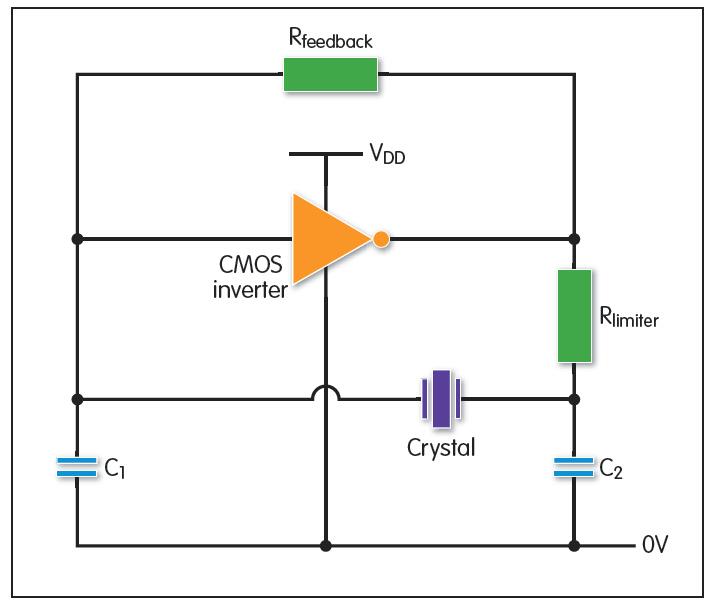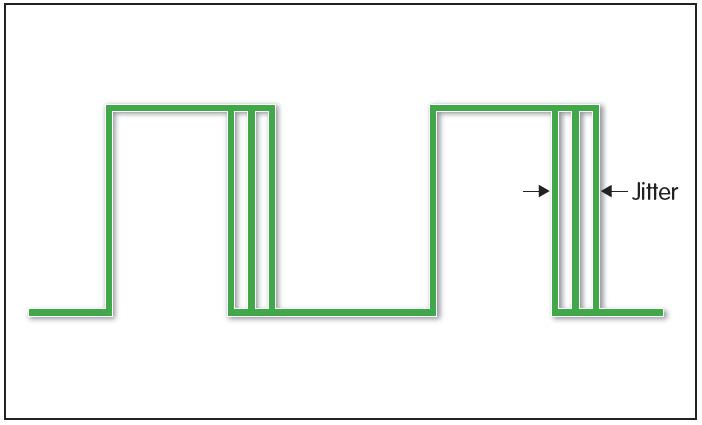he latest product to fall within this category is the IQXO-931, a low jitter clock oscillator in a 2.5 x 2mm six pad surface mountable package that can be specified at frequencies up to 1.5GHz.
Most clock oscillator designs are based on a gated pierce oscillator (see fig 1) that uses an unbuffered inverter, two capacitors, two resistors and the quartz crystal. In order to understand how the circuit operates, the inverting gate is considered to be a linear amplifier with gain, phase and delay constraints – it is not a logic device working with binary code.

| Fig 1: Most clock oscillator designs are based on a gated Pierce oscillator |
In the case of the IQXO-931, the oscillator uses an AT-cut crystal, in either fundamental mode or overtone mode at frequencies of up to 160MHz, and a low-noise phase locked loop (PLL) for multiplication up to frequencies of 1.5GHz. Using careful control of the production of the quartz crystal, overall frequency stabilities of ±30ppm can be achieved for a 10 year period and over operating temperatures ranging from -40 to 85°C.
The quality of the raw quartz, combined with the accuracy of production, has a critical effect on a finished crystal's frequency stability over temperature and its jitter performance. Although quartz occurs naturally in many locations in the world, it is far too impure with too many imperfections to be used in today's highly controlled electronics industry. As a consequence, techniques developed in the 1930s are used to grow it synthetically in autoclaves. By ensuring the synthetic quartz produced is as pure as commercially feasible, the subsequent effects on the phase noise performance can be minimised.
The quartz itself has the most effect on jitter close into the carrier frequency, thereby having a controlling effect on overall oscillator performance. The synthetic quartz is processed by cutting it into bars and then into wafers. The angle of this cut, which is made using a highly precise diamond saw, determines the final properties and performance of the finished product.
The other key parameter to consider is frequency/temperature performance; this drift must be kept to a minimum in order to ensure performance remains within band; in other words, how precisely the frequency is held versus fluctuating temperature. This needs to be at least as wide as the application demands and may need to take into account any element of external circuit conditions, such as internal self heating.
There are many angles of cut which can be used for different types of oscillator and the most common is the AT. This has the advantage of providing a good stability (typically less than 50ppm) whilst allowing for a high yield from the quartz bar, leading to a cost effective device. Techniques such as X-Ray selection are used in selecting the quartz blank, so a good indication of its performance can be gleaned prior to its fitment in the oscillator circuit.
The crystal in the IQXO-931 is housed in a hermetically sealed metal lidded ceramic package in order to minimise the effects of EMI radiation and to provide suitability for size critical applications; in particular, portable or battery powered systems or devices.
Phase jitter was the key consideration in the design philosophy of the IQXO-931. Phase jitter is a method of describing stability in the time domain. It adds all the noise sources together and shows their effect with respect to time. The time domain shows what the output looks like over a particular time period (see fig 2). In the case of the IQXO-931, phase jitter is less than 0.5ps rms over a bandwidth of 12kHz to 20MHz and, critically, this applies for whichever output is specified. In this respect, users needs to specify at point of purchase whether they require a HCMOS, LVPECL or a LVDS output. In the case of the HCMOS, this will be a single ended output; in the case of the latter options, it will be differential.

| Fig 2: Phase jitter is a method of describing stability in the time domain |
There are numerous potential applications for this product, including 100G Ethernet. The advantage the IQXO-931 brings to this application is the high frequencies that it can achieve. There is also the possibility that 100G Ethernet can be adapted to operate with existing SONET/ SDH digital networks, which are now widely in place worldwide. For these applications, it is likely that frequencies in excess of 400MHz will need to be considered, which should not be an issue considering the very low phase jitter performance of the oscillator.
Wi-Fi is probably the largest application by volume for this series of oscillators, with the proliferation of portable 'connected' devices with personal computers, video games consoles, digital cameras and tablets. The IQXO-931 has a typical current consumption of around 40mA from a 2.5V or 3.3V supply, making it suitable for such applications. Since this device is likely to be used in high volume applications, it is available on tape and reel and is RoHS compliant. The IQXO-931 is available across an extensive frequency range – from 8MHz to 1.5GHz – with many standard frequencies available. The metal lid design helps to minimise EMI radiation and since Wi-Fi operates on the 2.4GHz band, the likelihood of interference has been reduced.
Another potential application is Asymmetric Digital Subscriber Line – ADSL – still commonly in use for Internet connectivity by supporting data to be sent at higher rates over existing telephone cables. Within the ADSL modem, which is generally located close to the the end user, there will be a need for one or more oscillator for which the specification of the IQXO-931 is suited. Potentially, frequencies with a multiple of 70.656MHz, such as 282.624MHz, could be required, but this depends upon the engineering design.
With the seemingly inexorable rise in connected devices and new applications being developed on an almost daily basis, the pressure on bandwidth has never been greater. With higher frequency requirements increasing and the need to maintain signal integrity through ever-lower phase noise performance, the demands placed upon frequency products manufacturers has never been greater.
Peter Sinclair is applications support manager at IQD Frequency Products.













